This article was medically reviewed by Luba Lee, FNP-BC, MS. Luba Lee, FNP-BC is a Board-Certified Family Nurse Practitioner (FNP) and educator in Tennessee with over a decade of clinical experience. Luba has certifications in Pediatric Advanced Life Support (PALS), Emergency Medicine, Advanced Cardiac Life Support (ACLS), Team Building, and Critical Care Nursing. She received her Master of Science in Nursing (MSN) from the University of Tennessee in 2006.
There are 14 references cited in this article, which can be found at the bottom of the page.
wikiHow marks an article as reader-approved once it receives enough positive feedback. This article has 16 testimonials from our readers, earning it our reader-approved status.
This article has been viewed 360,815 times.
A hernia is caused by internal organs, like the intestines or stomach, pushing through an opening in your muscles or the tissues that hold your organs in place. They’re most common in your abdomen but can also occur in your upper thigh, belly button, or groin. They often aren’t painful and are mainly noticeable as a soft bulge underneath your skin, but sometimes they can grow and become more serious. If you’re experiencing pain and discomfort, you’ll likely need surgery to fix the hernia. You should always see your doctor for an official diagnosis if you suspect a hernia, and seek immediate medical attention if you have a fever, increased pain, constipation, or a hernia that changes color.[1]
Steps
Reducing and Managing Pain
-
1Take over-the-counter pain meds to help relieve your discomfort. Aspirin and ibuprofen may work well to alleviate some pain and swelling. Follow the recommended dosage on the bottle and don’t exceed the daily limit. If you find your pain doesn’t get better or if you keep taking more and more medication, it may be time to call your doctor.[2]
- If you take a blood thinner, always check with your doctor before using pain medication. They may want you to take something different so it doesn’t interfere with the blood thinner.
Types of Hernias: Almost all hernias will eventually need to be treated through surgery, especially if they’re bulging or causing you a lot of pain. Some of the more common types of hernias include:
Inguinal hernia: This type of hernia is in the groin area; it most often affects men, though women can experience it, too.
Femoral hernia: This hernia is located around the top of your inner thigh, caused by part of your intestines pushing through your groin. These are most common among older women.
Hiatal hernia: This hernia appears on your abdomen as part of your stomach protrudes into your chest cavity.
Umbilical hernia: This occurs when tissue pushes through your abdomen near your belly button. It can affect both infants and adults.[3]
-
2Avoid heartburn-causing foods and large meals if you have a hiatal hernia. This is the one type of hernia that sometimes doesn’t need surgery, especially if its symptoms can be managed through diet and over-the-counter antacids. If your symptoms increase over time, though, surgery may become the best solution.[4]
- Enjoy multiple small meals throughout the day instead of 3 larger ones. This will put less pressure on your stomach so you’re more comfortable all day long.
- Avoid caffeine, chocolate, garlic, tomatoes, and other fatty or fried foods that can cause heartburn.
- Don’t lay down after you eat for several hours.
Advertisement -
3Relieve discomfort from an inguinal hernia with a truss. A truss is a supportive undergarment that helps keep your hernia in place—it’s a temporary solution to help relieve pain until you can have surgery. You can buy a truss online, but it’s best to visit your doctor so they can make sure it’s properly fitted.[5]
- Most inguinal hernias do need surgery to be repaired, but if your hernia is really small and not causing you pain, your doctor may be okay with waiting and keeping an eye on it.
- Surgery may sound scary, but these procedures usually take less than an hour and should quickly help relieve your pain.
-
4Eat a fiber-rich diet to make bowel movements softer and easier to pass. Straining your muscles can aggravate your hernia, and constipation can make things worse. Add lots of fruits and vegetables to your daily diet, and consider taking a fiber supplement to help things move smoothly.[6]
- Oatmeal, nuts, beans, popcorn, chia seeds, and whole grains are also great high-fiber food choices.
-
5Lose weight to take pressure off of your abdomen. This can be helpful for all types of hernias; the less weight you’re carrying around, the less strain your muscles will be under. Try modifying your diet by eating leaner proteins and more fruits and vegetables, and try adding in some gentle exercise every day to lose weight.[7]
- Hernias can be really uncomfortable and it may be hard for you to imagine exercising. Try going for short 15-minute walks when you can, or go to the pool and slowly swim laps. Be gentle on yourself, though, so you don’t aggravate the hernia more.
Preventing Further Damage
-
1Avoid lifting bulky or heavy objects that may strain your muscles. Instead of bending over at the waist to pick up heavy items, bend your knees so you’re squatting. Bring the object close to you and then straighten your legs and stand up. Keep the heavy object at chest level and try not to twist and turn too much.[8]
- For heavy items you can’t lift yourself, consider using a dolly. You wedge the bottom of the dolly under the item, then use your weight to pull on the dolly’s handle to lift the object. From there, you can wheel it wherever it needs to go.
-
2Relax while going to the bathroom so you don’t strain your groin area. This is a little counterintuitive, but try to not strain when you have a bowel movement. Take your time and don’t push too hard; instead, let your body slowly work things out—it may take longer than usual, but it’s gentler on your body and can prevent further damage.[9]
- A high-fiber diet can help prevent hernias as well as manage discomfort if you already have one.
- Putting your feet up on a short stool may also make those muscles relax and help you go to the bathroom more easily.
- Add a hot cup of coffee to your morning routine. The heat and caffeine can help things get moving.
-
3Strengthen your abdominal muscles to prevent additional hernias. Weak muscles make it easier for your internal organs to break through your abdominal walls. The key to strengthening your core is to do so gently—too much pressure or exertion could actually cause a hernia, so start slow and stop any exercises that cause you pain.[10]
- Try doing 3 sets of 10 mini crunches every day. Lay on your back with your knees bent and put your hands behind your head. Use your ab muscles to bring your shoulders up off the ground 3 to 4 inches (76 to 102 mm) before carefully lowering yourself back to the ground.[11]
- Workout at the pool for low-resistance strength training. The support of the water will make it easier for you to exercise without having to strain your abdominals as much. Start slow if you’re new to swimming or doing water exercises, and enjoy your time in the water![12]
- Take a beginner’s yoga class to gently stretch and tone your core.[13]
-
4Quit smoking to improve lung health and eliminate excessive coughing. There are lots of reasons to quit smoking, and doing so can also help prevent hernias. Chronic coughing strains your muscles in both your abdomen and groin, so start curbing your smoking habit or quit cold turkey.[14]
- It can be extremely hard to stop smoking. If you’re having a hard time, talk to your doctor. They may be able to provide you with some kind of aid to help make the transition easier.
Seeking Medical Care
-
1See your doctor for an official diagnosis before treating yourself. You will likely recognize the signs and symptoms of a hernia on your own, especially if it’s large. However, it’s easy to misdiagnose yourself, so see your doctor to make sure what you have is a hernia. Your doctor will make a proper diagnosis so you can be sure you’re getting the right treatment.[15]
- Your doctor will do a physical examination to check for a hernia. They’ll look at the area and may press into it with their hands.
- In some cases, your doctor may do imaging tests to view the hernia.
-
2Talk with your child’s pediatrician if they develop an umbilical hernia. For infants and children under 5, always check with your pediatrician to see what they recommend. Many times, an infant’s hernia will close all on its own over time, but if it hasn’t gone away by the time your child is 5 years old, they may need a small procedure to have it fixed.[16]
- Umbilical hernias are common with infants, and they usually don’t cause your child any pain or discomfort.
-
3Let your doctor know if you have a hernia while you’re pregnant. Because of the extra strain on your body, hernias are fairly common among pregnant women. If you suspect you have a hernia, talk to your doctor so they can check it out. Your doctor will most likely want to wait until after birth and recovery before treating the hernia if you need surgery, but you and your baby should be safe in the meantime.[17]
- As much as you can, avoid heavy lifting and make sure to eat a high-fiber diet to prevent constipation.
-
4Visit your doctor as soon as possible if your hernia looks dark red or purple. This can be a sign that your hernia is strangulated. When this happens, your hernia is cutting off the blood flow to part of your intestine and requires medical treatment. Go to the doctor to make sure you’re okay because you may need emergency treatment.[18]
- Try your best to not worry or panic—your doctor will be able to fix your hernia.
-
5Seek emergency care if you have pain, nausea, vomiting, or blocked bowels. Sometimes a hernia can block off part of your intestines. This means your bowel movements can get caught behind the hernia, causing pain, nausea, vomiting, and bloating. You will likely not be able to pass gas or have a bowel movement. See your doctor or go to the emergency room if this happens because you likely need medical treatment.[19]
- This is a treatable condition, though it can be really scary at the moment. As soon as you suspect a problem, get medical attention so you can get back to normal as soon as possible.
-
6Have a surgical procedure done to correct your hernia and prevent future ones. These procedures are generally pretty quick and you should get to go home that same day. The surgeon will usually make a small incision near the hernia and push it back into place. From there, they will sew and reinforce the tear so that the hernia will be less likely to protrude again.[20]
- Make sure to follow all recovery instructions after your surgery. You’ll need to take it easy and avoid heavy lifting for a while, and you’ll probably also have pain medication to take.
Expert Q&A
Did you know you can get premium answers for this article?
Unlock premium answers by supporting wikiHow
-
QuestionI have an umbilical hernia. After my operation, is there a chance that I can get back to mixed martial arts?
 Zora Degrandpre, NDDr. Zora Degrandpre is a Natural Health Doctor and Licensed Naturopathic Physician in Vancouver, Washington. She is a grant reviewer for the National Institutes of Health and the National Center for Complementary and Alternative Medicine. She received her ND from the National College of Natural Medicine in 2007.
Zora Degrandpre, NDDr. Zora Degrandpre is a Natural Health Doctor and Licensed Naturopathic Physician in Vancouver, Washington. She is a grant reviewer for the National Institutes of Health and the National Center for Complementary and Alternative Medicine. She received her ND from the National College of Natural Medicine in 2007.
Natural Health Doctor
-
QuestionIs it okay for me to do squat thrusts with an inguinal hernia?
 Zora Degrandpre, NDDr. Zora Degrandpre is a Natural Health Doctor and Licensed Naturopathic Physician in Vancouver, Washington. She is a grant reviewer for the National Institutes of Health and the National Center for Complementary and Alternative Medicine. She received her ND from the National College of Natural Medicine in 2007.
Zora Degrandpre, NDDr. Zora Degrandpre is a Natural Health Doctor and Licensed Naturopathic Physician in Vancouver, Washington. She is a grant reviewer for the National Institutes of Health and the National Center for Complementary and Alternative Medicine. She received her ND from the National College of Natural Medicine in 2007.
Natural Health Doctor
-
QuestionI am mother of two. The first delivery was Cesarean, and an incision hernia developed. I had it operated on after ten years, but after one year, the problem is occurring again. A lump is on the right side of my lower abdomen, though mesh was placed during operation. What should I do first?
 Zora Degrandpre, NDDr. Zora Degrandpre is a Natural Health Doctor and Licensed Naturopathic Physician in Vancouver, Washington. She is a grant reviewer for the National Institutes of Health and the National Center for Complementary and Alternative Medicine. She received her ND from the National College of Natural Medicine in 2007.
Zora Degrandpre, NDDr. Zora Degrandpre is a Natural Health Doctor and Licensed Naturopathic Physician in Vancouver, Washington. She is a grant reviewer for the National Institutes of Health and the National Center for Complementary and Alternative Medicine. She received her ND from the National College of Natural Medicine in 2007.
Natural Health Doctor
Warnings
- Without surgical repair, some hernias will simply get larger. You should always see your doctor if you’re suffering from a hernia.[22]⧼thumbs_response⧽
- If you experience nausea, vomiting, fever, increased pain, constipation, or discoloration of your hernia, call your doctor immediately.[23]⧼thumbs_response⧽
References
- ↑ https://www.mayoclinic.org/diseases-conditions/inguinal-hernia/symptoms-causes/syc-20351547
- ↑ https://www.drugs.com/cg/inguinal-hernia.html
- ↑ https://my.clevelandclinic.org/health/diseases/15757-hernia
- ↑ https://www.mayoclinic.org/diseases-conditions/hiatal-hernia/diagnosis-treatment/drc-20373385
- ↑ https://www.mayoclinic.org/diseases-conditions/inguinal-hernia/diagnosis-treatment/drc-20351553
- ↑ https://my.clevelandclinic.org/health/diseases/15757-hernia/prevention
- ↑ https://my.clevelandclinic.org/health/diseases/15757-hernia/prevention
- ↑ https://www.drugs.com/health-guide/inguinal-hernia.html
- ↑ https://medlineplus.gov/constipation.html
- ↑ https://www.drugs.com/health-guide/inguinal-hernia.html
- ↑ https://www.mayoclinic.org/healthy-lifestyle/fitness/multimedia/core-strength/sls-20076575?s=2
- ↑ http://www.acsm.org/docs/default-source/files-for-resource-library/starting-a-swim-training-program-to-improve-fitness.pdf?sfvrsn=2e3da08_2
- ↑ https://connect.mayoclinic.org/page/cancer-education-center/newsfeed-post/benefits-of-yoga/
- ↑ https://www.mayoclinic.org/diseases-conditions/inguinal-hernia/symptoms-causes/syc-20351547
- ↑ https://www.mayoclinic.org/diseases-conditions/inguinal-hernia/symptoms-causes/syc-20351547
- ↑ https://www.uofmhealth.org/health-library/rt1510
- ↑ https://americanpregnancy.org/pregnancy-complications/hernia-during-pregnancy/
- ↑ https://www.mayoclinic.org/diseases-conditions/inguinal-hernia/symptoms-causes/syc-20351547
- ↑ https://www.mayoclinic.org/diseases-conditions/inguinal-hernia/symptoms-causes/syc-20351547
- ↑ https://www.mayoclinic.org/diseases-conditions/inguinal-hernia/diagnosis-treatment/drc-20351553
- ↑ https://www.urmc.rochester.edu/encyclopedia/content.aspx?contenttypeid=85&contentid=p00387
- ↑ https://www.mayoclinic.org/diseases-conditions/inguinal-hernia/symptoms-causes/syc-20351547
- ↑ https://www.mayoclinic.org/diseases-conditions/inguinal-hernia/symptoms-causes/syc-20351547
About This Article
To treat a hernia at home, try an over the counter painkiller like aspirin to help relieve discomfort in the affected area. Then, prevent the hernia from getting worse by avoiding spicy foods, caffeinated drinks, citrus fruits, or anything else that can cause gastric upset. Additionally, eat 6 small meals throughout the day, since large meals can result in stomach acid moving into the esophagus. Along with dietary changes, try walking for at least 45 minutes every day to strengthen the abdominal muscles and pelvic floor. For more advice from our Medical reviewer, including how to tell what type of hernia you have, keep reading.
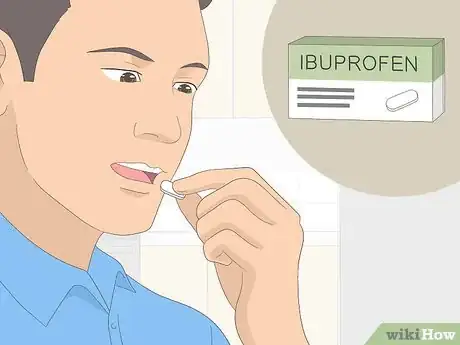
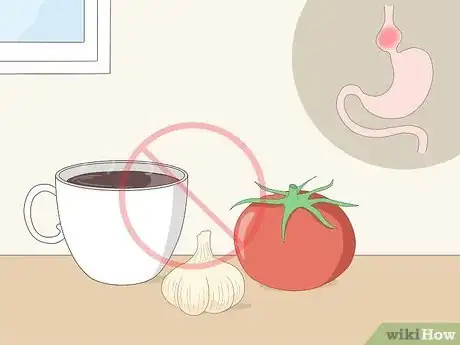
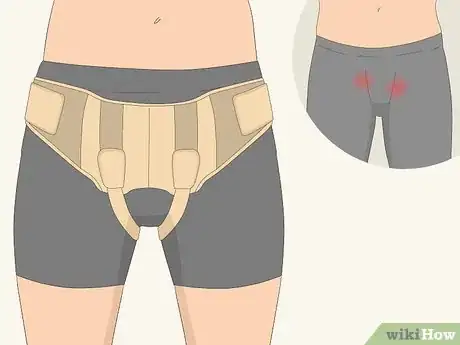

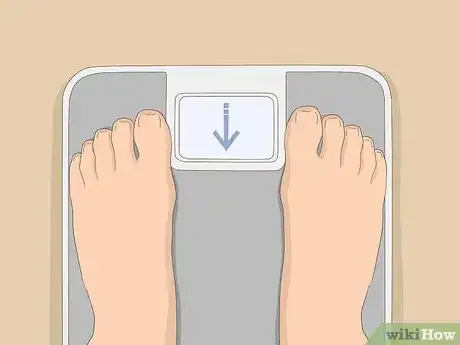
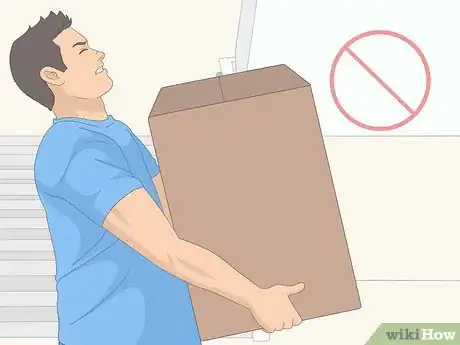
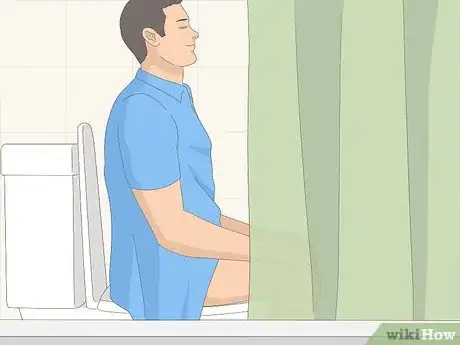
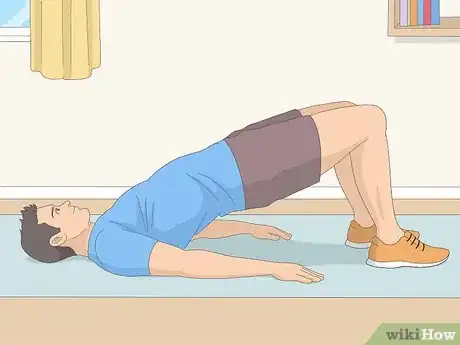
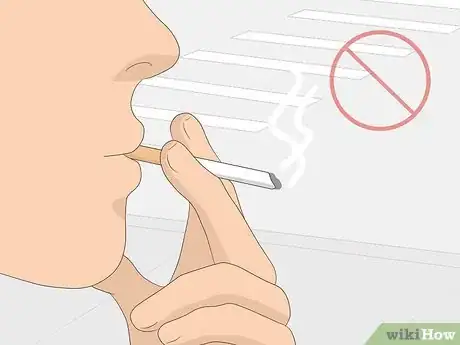
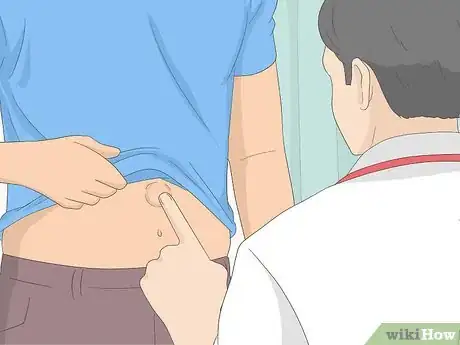
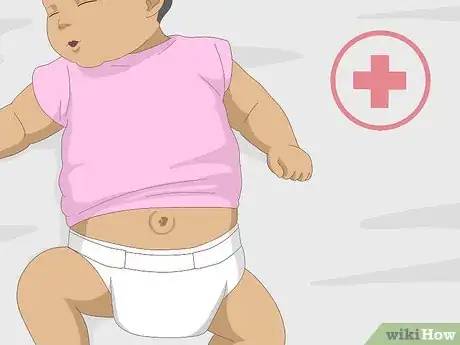

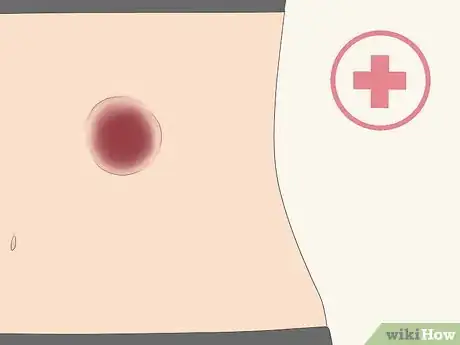
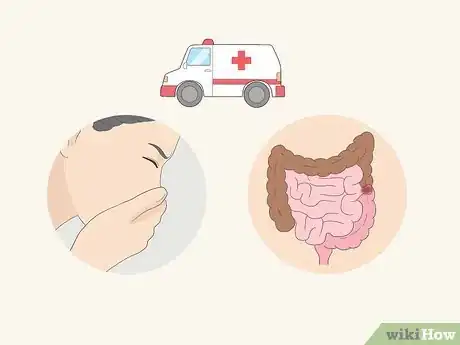
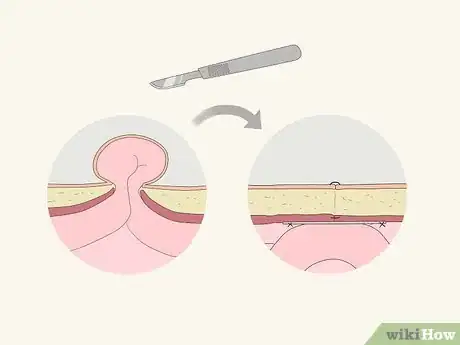
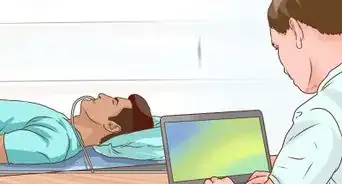



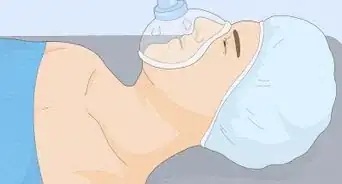



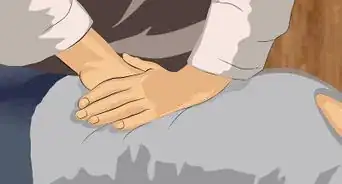
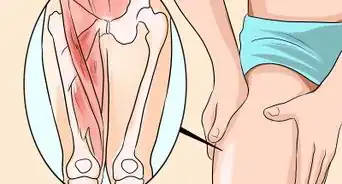
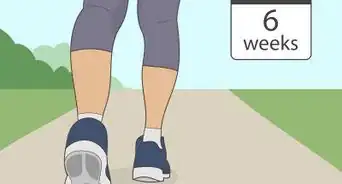
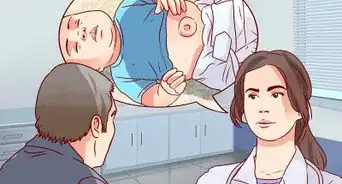










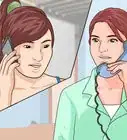





































Medical Disclaimer
The content of this article is not intended to be a substitute for professional medical advice, examination, diagnosis, or treatment. You should always contact your doctor or other qualified healthcare professional before starting, changing, or stopping any kind of health treatment.
Read More...